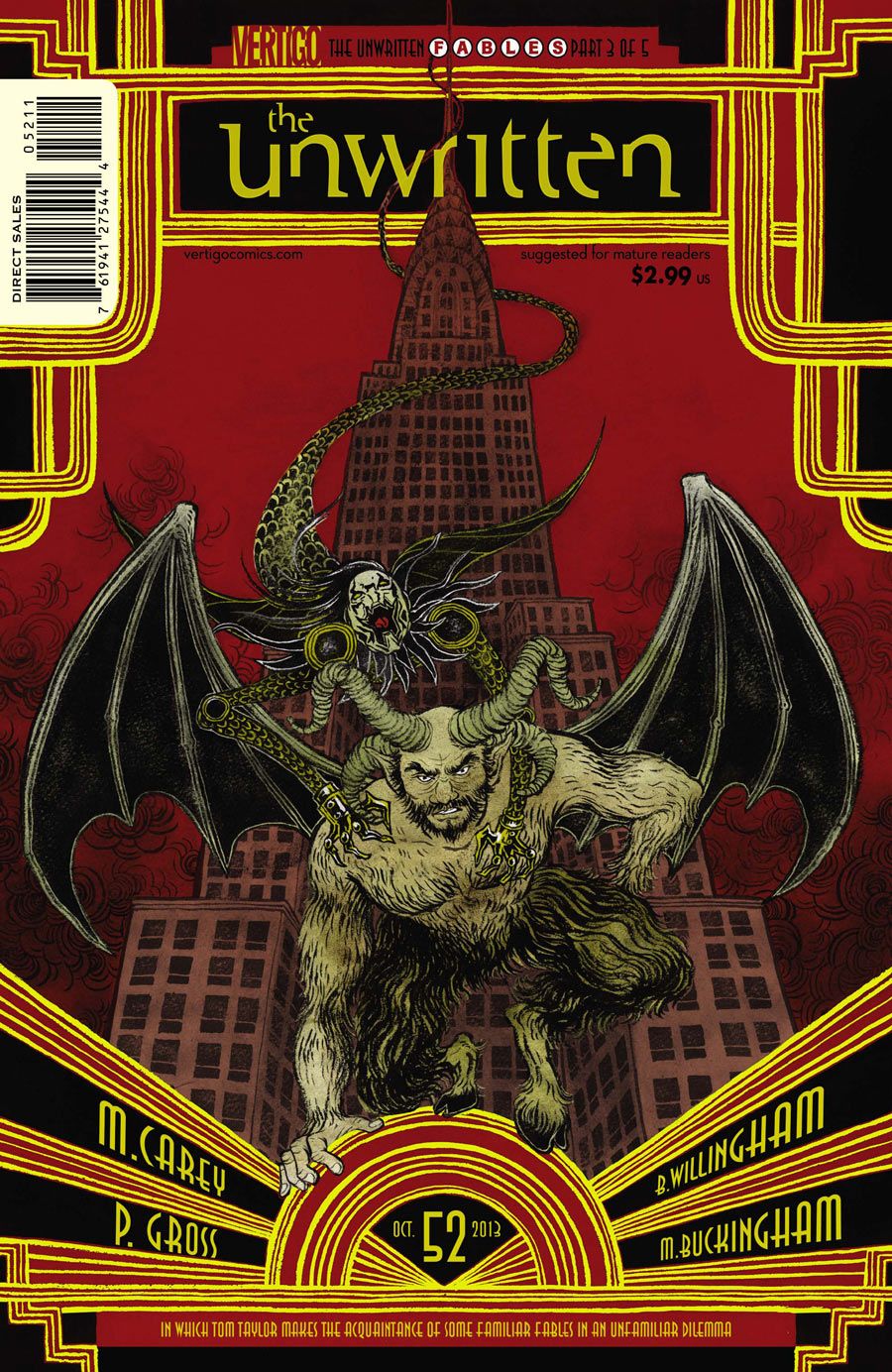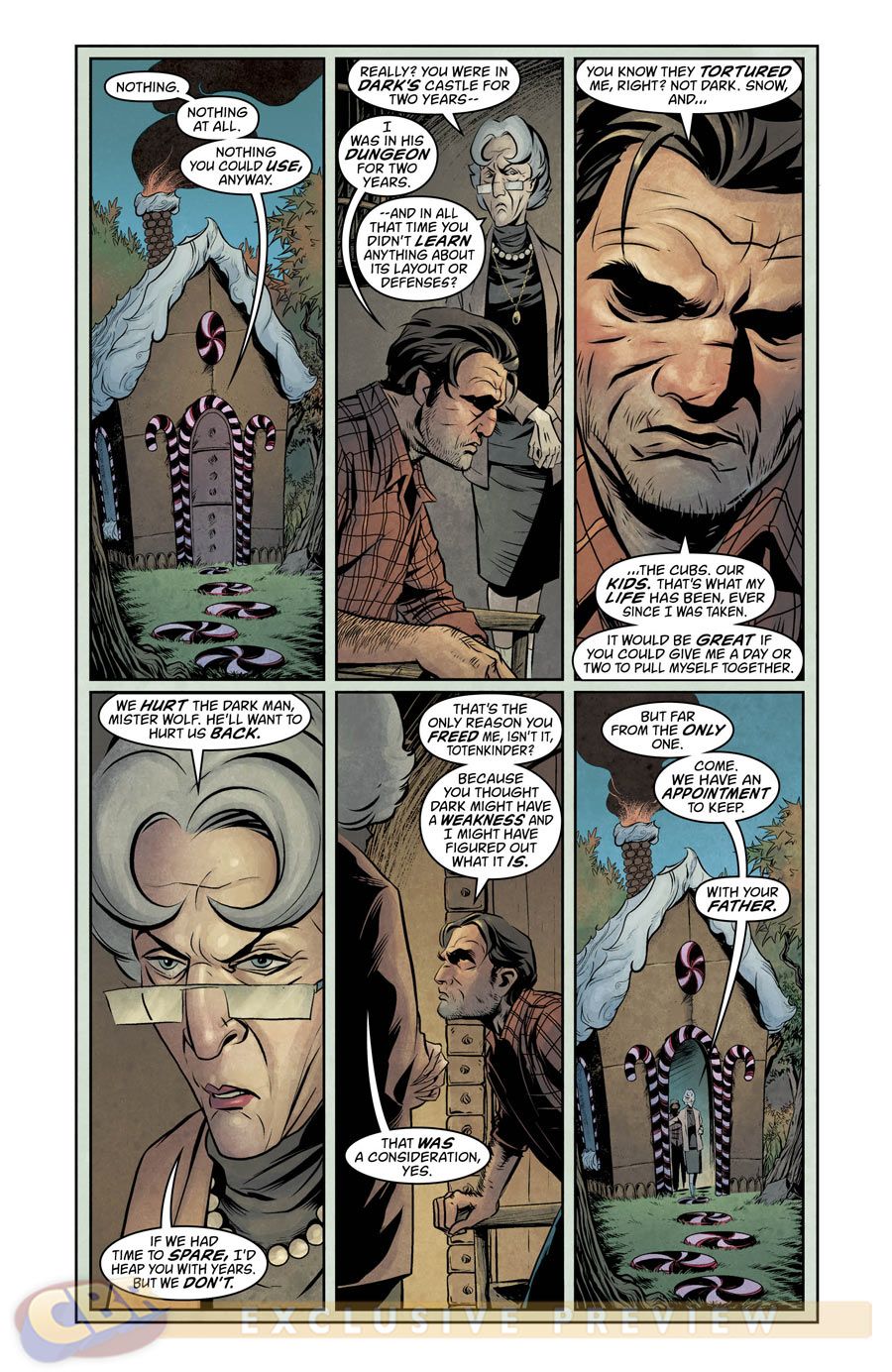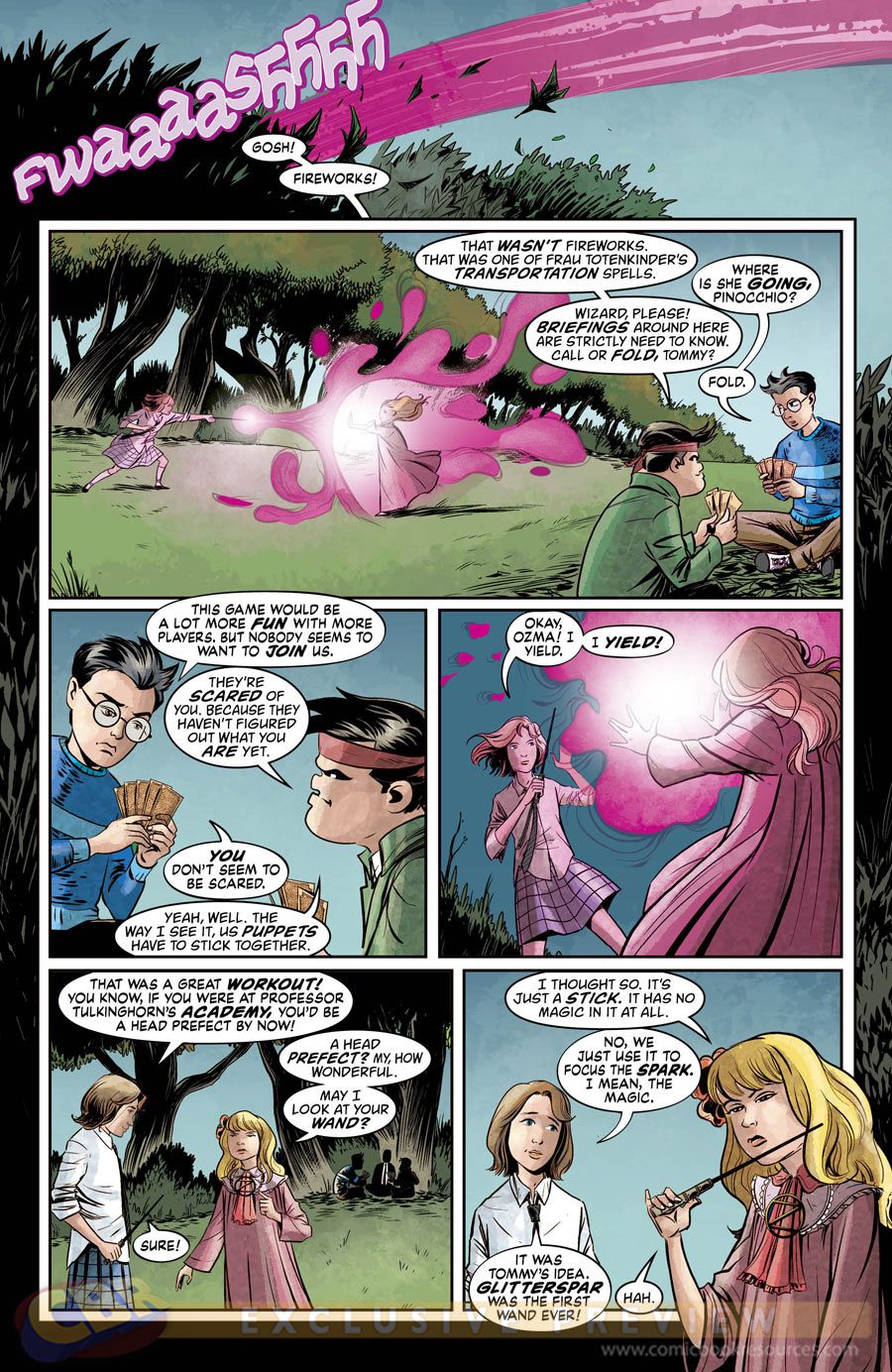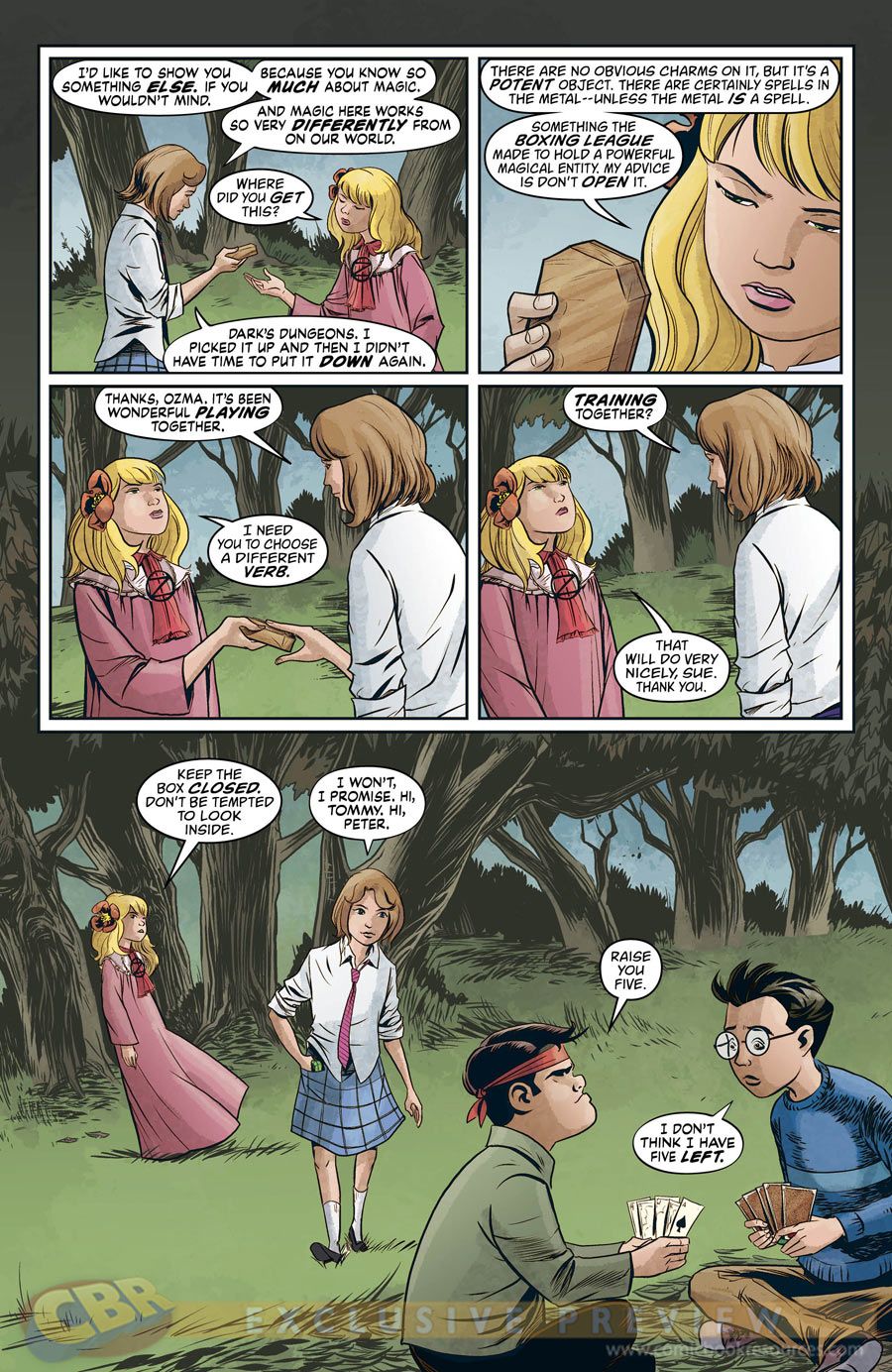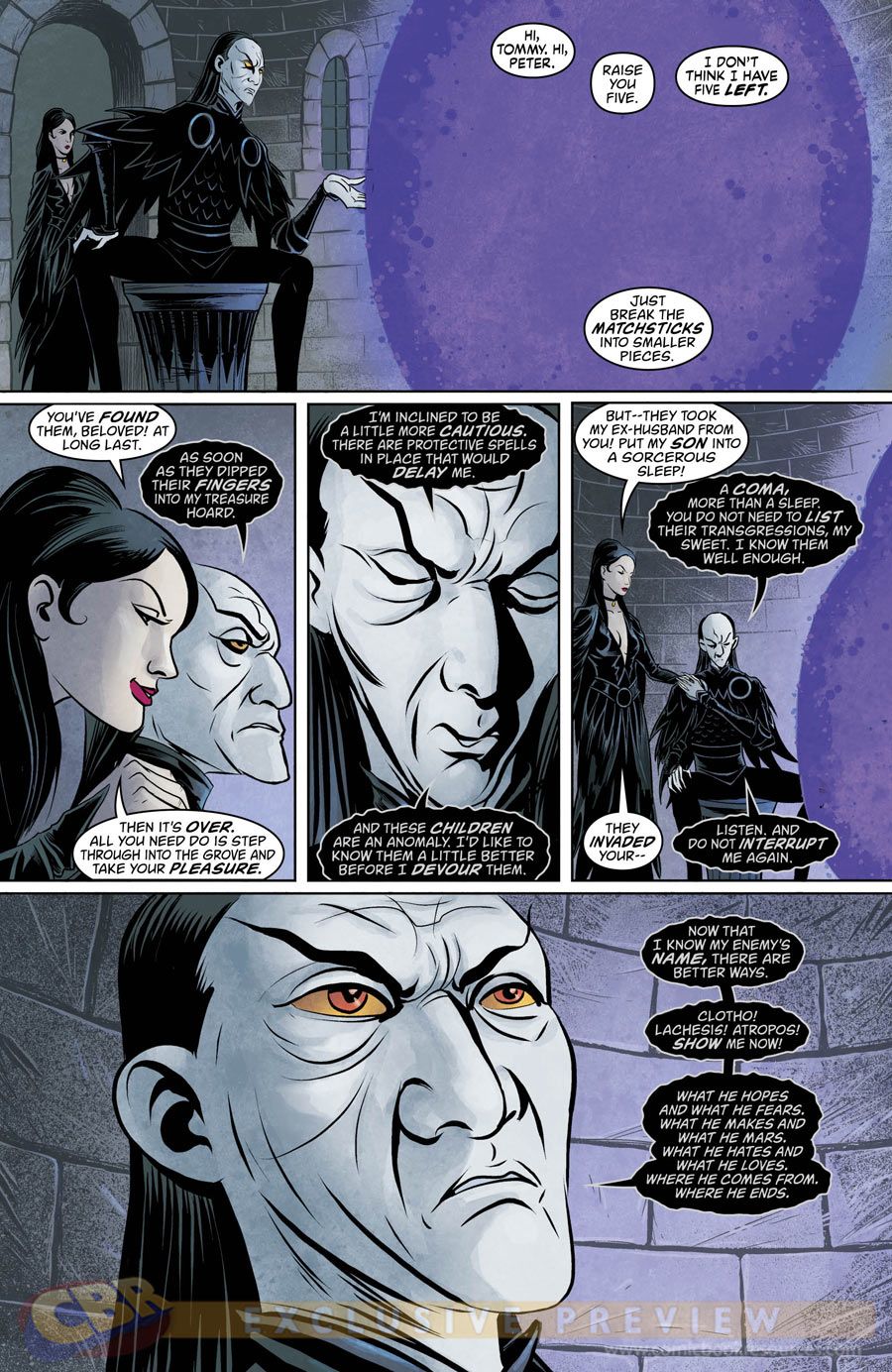As fans of the "The Unwritten" await the release of "Tommy Taylor and the Ship that Sank Twice" -- an original graphic novel spinning from the pages of the monthly Vertigo title -- creators Mike Carey and Peter Gross dropped a bombshell, revealing that their critically acclaimed series ends in October with the close of the current "Unwritten Fables" arc, only to relaunch in January with a new #1.
CBR News connected with the long-time collaborators, the two also worked together in the 2000s on the "Sandman" spinoff "Lucifer," to discuss the decision, as well as hear their thoughts on the current arc of "The Unwritten," which features characters from Bill Willingham's "Fables." For unreaders, "The Unwritten," which launched in 2009, tells the story of Tom Taylor, a young man who has lived his life being famous as the namesake of Tommy Taylor, the boy wizard from the bestselling series of novels written by his long-lost father, Wilson Taylor. After a series of strange events in his real-life begin to mirror happenings of Tommy's fictional adventures, Tom begins to realize (and finally accept) that he might actually be Wilson's creation made flesh.
The original graphic novel is partly told through Wilson's journal entries but the main narrative is basically the first novel in the Tommy Taylor fantasy series.
Teased as both a prequel and a parallel story to "The Unwritten," "Tommy Taylor and the Ship that Sank Twice" features Tommy's wizarding pals Peter Price and Sue Sparrow, and also introduces new characters to the mythos, including Tommy's parents Sebastian & Leona and Professor Tulkinghorn, who serves as Dumbledore to Tommy's Harry Potter, or perhaps the John Constantine to Tommy's Timothy Hunter.
CBR News: Before we get to "Tommy Taylor and the Ship that Sank Twice," the big news is the announcement that "The Unwritten" is ending in October with #54 and relaunching with a new #1 in January. How did you come to this decision?
Mike Carey: It seemed like a good way to mark what is a natural break when you get to the climax of "The Unwritten Fables" arc, and when you get there, you'll see what we mean. It's a huge, game-changing event yet at the same time, it plays very naturally into what we have planned as the last act of the book. Obviously, we've been working flat out to finish the graphic novel, and we started "The Unwritten Fables" arc with a double-sized issue, so there was a sense in which it was useful to us to have a pause before we carried on. But again, it also felt like it served the story.
I'm loving "The Unwritten Fables." It's not at all what I expected, but I am thoroughly enjoying the interplay between Tom Taylor and Frau Totenkinder and the other magical characters of Fabletown. Did you know this break was going to happen when you started this crossover, or did it grow organically from the storytelling and production?
Peter Gross: It developed while we were working on "The Unwritten Fables." Mike and I started talking about the consequences of this arc; we wanted it to have consequence. We wanted it to be more than just an event that was meaningless. As we talked more and more about where Tom was going to be after this, we realized that the overall story would be so different. When we started talking to [Vertigo Executive Editor] Shelly [Bond] about it, it became evident that we would like to mark the change with a new numbering.
Hopefully, it encourages more people to pick up the book. I think we gained some readers from "The Unwritten Fables" arc and this will make for an easy jumping-on point. But this is as much or more about how different a place the book starts out, again, after that.
Carey: Looking at where we were in the structure of the story, and realizing that there was so much story left to tell, it seemed like a logical thing to do -- taking a slight pause before heading into the next phase.
Gross: And a much needed break for me. [Laughs]
Will the second volume be similar in length to the first?
Gross: It's not going to be that long.
Carey: No, these will be the final arcs. This is Act 3 of the story.
Gross: I think if you look back to the end of "The Unwritten" #35, there was a big climax with Tom and Pullman and that was kind of the official end of Act 1. "The Unwritten Fables" is the more official end of Act 2.
Is working with Bill Willingham and Mark Buckingham on "The Unwritten Fables" what you expected?
Carey: It's hugely enjoyable. The creative jamming between Bill and Bucky [Mark Buckingham] has been enormously enjoyable. We've had a wonderful time. The reception has been cautious in some circles. People that are already reading "Fables," as well as "The Unwritten," are getting a lot out of it, while people that are not "Fables" readers are feeling there way through it a little more cautiously, asking, when are "The Unwritten" beats going to come in? They come in more strongly as the arc goes on. Gross: We have had a blast working on it.
Let's leave that for now, as there is still more story to tell in "The Unwritten Fables" and I don't want you spoiling it. Meanwhile, in "Tommy Taylor and the Ship that Sank Twice," you're telling an origin story for Tom and Tommy by interplaying a Tommy Taylor story by Wilson Taylor with a recounting of Tom's own real-life beginnings. Can you take us back to early days of this project and what led to its development?
Carey: I think the original inspiration came from Peter. We both really, really enjoyed doing the little extracts from the Tommy Taylor novels and we were kind of itching to do that on a larger scale and Peter started thinking seriously about what that would mean and about the structural inversion that we could exploit. Traditionally, we would use a tiny Tommy scene as punctuation in a Tom story. And there was no reason that it shouldn't work the other way around with the Tommy story being the main spine of the narrative with the glimpses into Tom's world and Wilson's world being the intermissions.
Gross: The idea was that it would be really cool to tell an "Unwritten" story from the Tommy story point of view as a counterpoint to main the book. Flip the coin and reverse the format. I was thinking big at the beginning: "If this works, we can do all of the Tommy Taylor books." [Laughs] But I didn't realize what an incredible amount of work that would be to get it done. I don't think we'll ever being seeing all of the Tommy Taylor books... unless this sells so phenomenally well that we just can't stop ourselves.
Carey: We certainly sold ourselves on the characters. There is a sense in which Tommy Taylor and Peter Price and Sue Sparrow start out as generic figures. You might look at them and see other characters from other fantasy narratives and yet the more we wrote them and drew them, the more we felt like we knew what they were about. We knew that there was a distinctive character hiding underneath the archetype.
Gross: I think that's why they actually show up in "The Unwritten Fables." Initially, when we were talking about doing "The Unwritten Fables," I don't think we were thinking along the lines of having Tommy, Sue and Peter appear in the story, but we were so immersed in them from working on the OGN, they had become real characters for us and I think we wanted to get them into the main book, too.
Carey: Those are the most enjoyable scenes to write, actually.
There's a great line early in the graphic novel from Wilson Taylor that reads, "[T]o make my character such a powerful archetype that he works backwards and erases his own precursors." Lofty self-praise by the creator of Tommy Taylor, but in essence, is that what you have to do as the creators of "The Unwritten?" There has to be more than the archetype if you want to create something that lasts.
Carey: Certainly, something came out of the archetype that made them quite distinctive and that made us want to pursue it and explore it. It's loads of fun getting to the heart of those characters.
Gross: I think that line is Mike justifying our own thievery over the years. [Laughs]
There is another great line in the graphic novel -- well, there are lots of great lines, but another great line early on comes from Wilson that he's trying to work into his story. "The sea was like the Earth turned upside down." Why is water so important to storytelling of "The Unwritten?" There seems to be no end to the water references throughout the series, from Leviathan and Moby Dick to the river Styx and the ship that sank twice.
Carey: There is that moment in the Leviathan arc where the Frankenstein monster basically tells Tom that there is only one ocean. There are so many, many stories which the ocean features, you can use it as a conduit to go from one story to another because the ocean is always the same. So in that sense, there is an organic, unbreakable substrate underlying all of the fictional worlds. That was one of the reasons why it was cool to have Leviathan be an aquatic beast.
Gross: Also, water tends to symbolize the unconscious and dreams and stories. For us, it's kind of the same thing. Water is the medium that Leviathan lives in and that sustains Leviathan whether it's our subconscious or the substance that stories are made of. It just works as a great metaphor.
Carey: There is also this thing that we used way, way back in one of the early issues of "Lucifer," that if you look at the origins of life, it obviously originated in the sea -- the blood of living creatures was initially just internalized sea water. I think there's a line in Lucifer that goes, "Within our hearts, there's a lifeless ocean." There is also the inferiority of Leviathan, as well -- the fact that Leviathan is both inside and outside us.
While he wasn't the most likable character when he was first introduced, I've grown to love Tom Taylor over the course of the series. Wilson was introduced as a terrible person and has grown into a monster in the series, but in "The Ship that Sank Twice" -- I don't know if I like him more, but I guess I do have a better understanding of what drives him and why he is the way he is. Likewise, with Tommy being introduced and not Tom, he's far more likable from the get-go, too.
Carey: [Laughs] I think Wilson's still a monster, but certainly our intention was to make his motives a little more transparent. I guess to that extent, if you understand him more, you have to hate him less, but there is no denying that he treats everyone around him terribly. His treatment of Sue Morgenstern is truly horrific.
Gross: He has a purpose. The question is, are you going to forgive him by the end of the series, or aren't you? He literally says that in "The Unwritten" #49 to Tom. When they're in Hell, he says, "Do you understand what I'm doing now?"
Carey: Of course, one of the key moments in the graphic novel is when he has that nightmare and he's trying to explain himself to Tom, which is, of course, a premonition of his own death.
In "The Ship that Sank Twice," you introduce this concept of the Spark, which, in a literal sense, is the twinkle in a young person's eye that indicates he or she is magical. Have you seen the Spark in someone? Do you feel you have the Spark?
Carey: I grew up loving the "Earthsea" novels by Ursula LeGuin. They were some of the first fantasy novels that I really got hooked on, and it's fascinating to see as the sequels go on, she starts to fight against the fantasy tropes that she's using in the early novels. Particularly, the idea the autocratic power of the wizard school on Roke. In the same way, we start off the graphic novel in a situation where there are wizards that regard themselves as superior to the Spark-less because they have this innate talent, this knack. We end, obviously, in a much more democratic situation, where Tommy has scattered the Spark to everybody, so I think we were exploring the conservatism of that kind of fantasy situation where there are magic users and there are non-magic users and non-magic users are... well, they're Muggles. They're slightly contemptible. They're slightly less interesting, and the real action is going on somewhere else. We wanted to get beyond that, I think.
Gross: In some ways, it's also a metaphor for creativity. That said, you also have to put it in context of Tom, in the main book, what the Cabal has, and what Tom has that other people don't.
There is an important scene in the book involving a blank piece of paper where Tommy solves Tulkinghorn's version of the Kobayashi Maru. Does the blank slate represent the stories that have yet to be written or those that have been left unwritten? Am I digging too deep?
Gross: I think it comes down to the question that we've been asking from the beginning: Are we all part of a story? Are we all making up the story, or are we all characters in the story? Yes, I think that's part of what's going on with that blank slate. Who makes up the stories? And what are the consequences of them?
Carey: Who makes the world?
While "The Ship that Sank Twice" is, at least early on, very much about the relationship between Tom and Wilson, the book also introduces Tommy's wizarding parents, Sebastian and Leona. Why is this the time to tell their story?
Carey: Tommy's birthright was right at the center of it. We wanted an origin story for him that would be a little bit fresher than usual, that tied into the glimpses we'd already established in Tommy's world in the main series. He's the greatest wizard of his world. He's the Tim Hunter of his world. Or the Harry Potter. He's the unique, übermage. And we wanted to give him an Odyssey -- mountains to climb and oceans to cross. That was part of the idea. Also, there are some hints within the book that maybe Tommy's origin is a little more complicated than we're being told. We know Tulkinghorn has a passion for Tommy's mother. Is there a possibility that Tommy's parentage might be different from what we know? It's very, very lightly left in there.
Gross: Mixed into that is Wilson's idea of what being a parent is. I find it fascinating that Wilson is writing about a kid and giving him parents, and I don't think Wilson is capable of understanding what that would be like. Because of that, with all of the ideas of Tommy's parentage, you have to take Wilson's abilities and intentions into account. I think that's why Wilson needed to get the parents off stage as quickly as possible. They are more concept than reality.
Carey: It is a weird thing that Wilson has created Tom, because he needs Tommy. He needs this narrative to emerge, which mixes fact and fiction and fiction and fact. And he does this all very, very cold-bloodedly. Yet there are moments when he becomes a real father, when he engages with the little boy, almost against his will. He seems surprised almost that there is this connection.
Wilson at one point says, "I've fathered a child of the mind and a child of the flesh." I think I know the answer to this, but is he a better father to Tommy than he is to Tom? Even in the book, he has Tommy's parents make a great sacrifice at Tommy's expense just as he made with Tom.
Carey: That's very true. On that level, Tommy's story absolutely mirrors Tom's. His parents make the decision to use Tommy's powers for the greater good. Tom's personal arc is very much foreshadowed in that first novel.
I also love this concept of the Proving and final test for the wizarding students to become full wizards. Now that Tommy has shared the Spark with all the word, is there no more need for the Proving in order to proving ourselves, or do we all now have the ability to prove ourselves?
Gross: I think this would just be the beginning.
Carey: In the reality, I guess the ending of the story is so radical that there is kind of a disconnect between it and the later Tommy Taylor novels that we've seen. But I think, yes, nobody has to prove themselves to anybody but themselves. There is no more external authority. There is no one there to say, "You have it. And you don't."
Gross: Though, it's probably like giving democracy to Egypt. [Laughs]
I can't let you go without discussing another one of my favorite characters, as this book also marks the return of Count Ambrosio. In his origin story, am I right in seeing a connection between him and Wilson Taylor, too?
Carey: I like that idea that there is this dark echo of Wilson in Ambrosio.
Gross: As a writer or a creator, everyone in that book is a reflection of Wilson. Peter Price's mother is Wilson. The Cabal is Wilson. Leviathan is Wilson. Tulkinghorn is Wilson. It's just interesting to see which parts he's acknowledging and which parts he's putting in subconsciously. I think the only characters that aren't a part of him are Tommy, and maybe Sue and Peter.
But by your own definition, isn't Tommy part of Wilson too?
Gross: Tommy is the thing Wilson is trying to make real, trying to create and give to the world. He's trying to create life by writing these books, by writing Tom. But that's a good question. Is Tom a part of him or not? Carey: Certainly, Wilson denies the link between Tom and Sue. He's not the slightest bit interested in her stake in Tom, either psychologically or in terms of the way they live. He cuts her out ruthlessly. He wants Tom to be his creation, entirely.
Gross: The one thing that happened when we were making this was -- and I think the script was done as we were doing the Tinker arc in "The Unwritten" -- is that we showed that Wilson had another kid besides Tom in the main book and that affected the way we were looking at this. We had to tweak the script for this to reflect the fact that he was involved in creating life before, unintentionally -- and with consequences. But he learned lessons from that to guide him through his creation of this life.
Carey: One of the weird things about the process of the OGN, and which turned out to be really, really advantageous and I think very useful, was that Peter left the Wilson pages until the very end. He came to draw them a long, long time after I wrote it. He would call me up and we would have very long conversations about what was there and whether or not we had to change it to reflect what had happened in the book since, and whether there were opportunities to foreshadow things that were coming up. Those pages were subject to change more than any other in the end.
"Tommy Taylor and The Ship that Sank Twice" is set for release on September 18.


